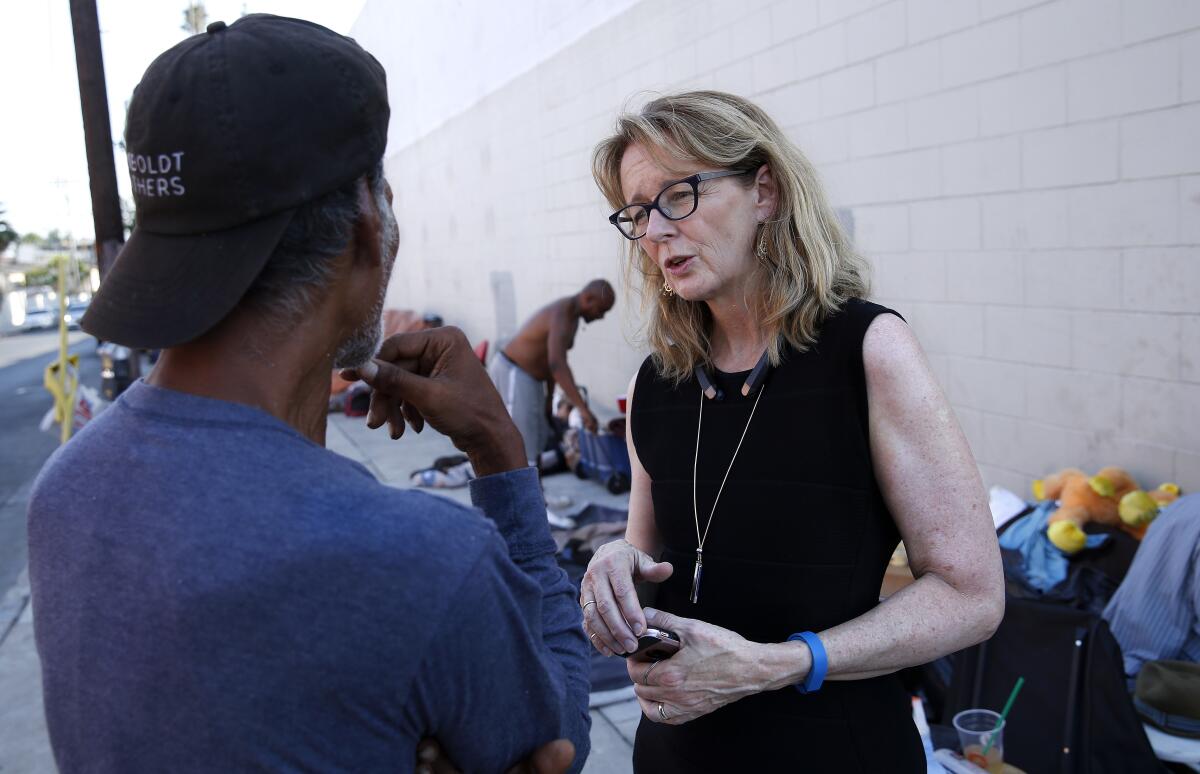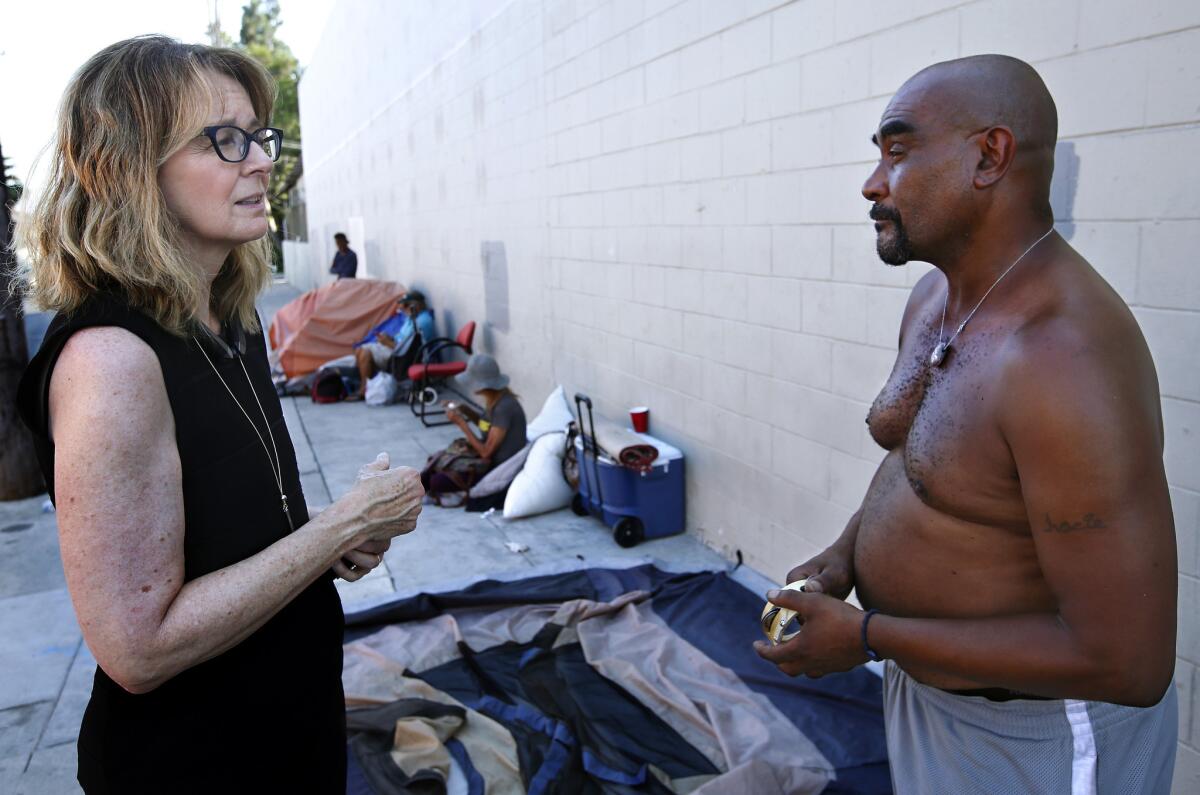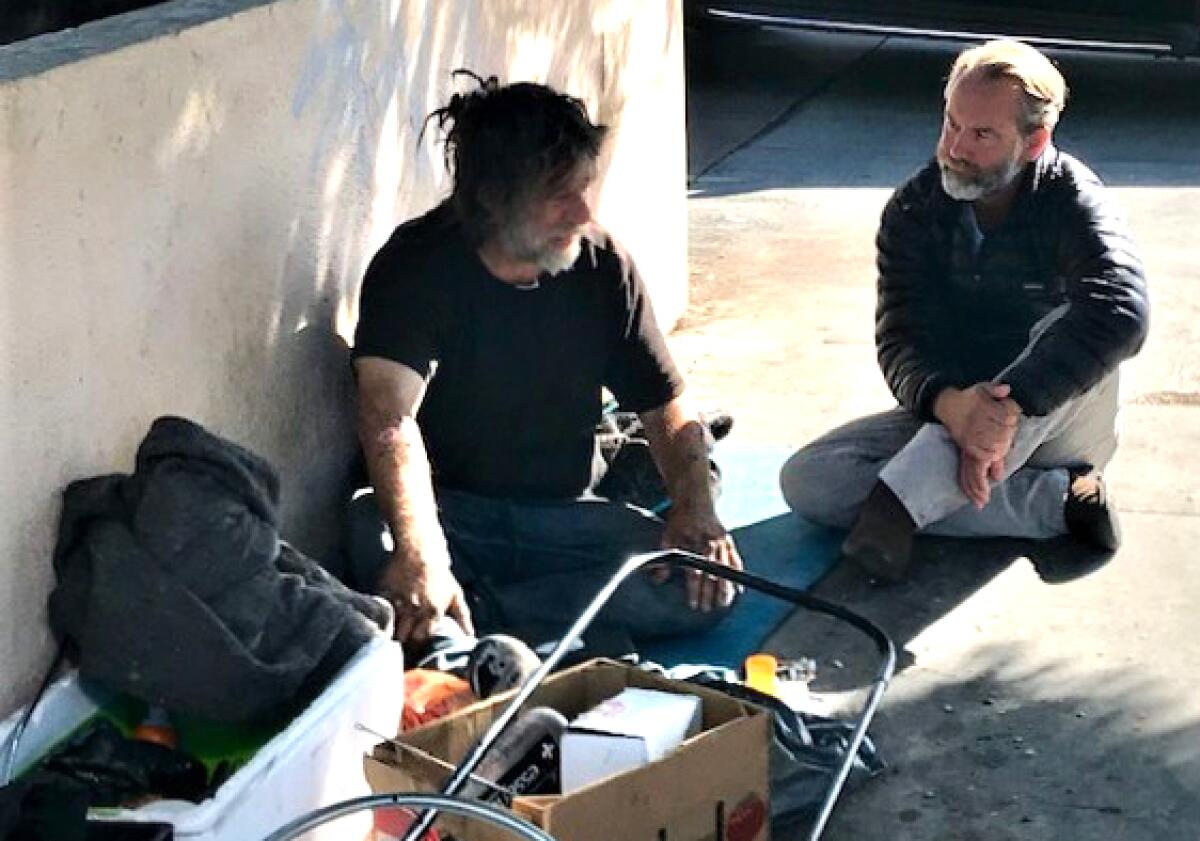Column: Shamed by Hollywood homeless catastrophe, she went to Italy for answers

Kerry Morrison had seen enough. She was not a clinician or policymaker, and she didn’t know what the answers were. But she knew she was looking at failure, and she knew she could no longer ignore it.
All around her, in the heart of Hollywood, people were living in subhuman conditions, sprawled beside storefronts and at bus stops. Their clothing was shredded, their bodies were black with grime, and their unattended madness was a daily indictment of public compassion and will.
“I couldn’t reconcile the sight of cranes, signifying progress, while stepping over mentally ill people on the street,” said Morrison, who was director of the Hollywood Property Owners Alliance for many years, and a decade ago began taking a closer look at the growing homeless population.
I remember wondering briefly, when I met Morrison back then, if she was more interested in cleansing the streets on behalf of the business interests she represented than in helping those who were suffering. But she and I were soon sharing notes on our daily interactions with those who were struggling, and on social workers who against all odds were making a difference.
“I felt called to this,” Morrison says now.
She reached out to professionals, joined boards, helped launch a campaign to identify and help the 14 most dreadfully ill people living on the streets of Hollywood. Morrison researched mental health policy and the history of what went wrong in the United States, and in particular in Los Angeles, where against a backdrop of economic progress and wealth, sick people were living in squalor.

Morrison won a fellowship to further her studies, checked out mental health programs in other U.S. cities, and traveled to a town in Belgium where families “foster” adults with mental illness. Last year, she gave notice to the property owners group that she’d be leaving her job in February to devote her full attention, unpaid, to her cause.
But it was a trip to Trieste, on the uppermost rim of the Adriatic in Northern Italy, that turned her despair into hope. It was there, in the summer of 2017, that Morrison found a mental health model in which every patient was looked after and no one was left to pitch a tent and fend for themselves. And it was there that she began mapping a plan to bring the Trieste model home to Hollywood.
Morrison tells a story about that first visit to Trieste, when she asked a young psychiatrist named Tommaso Bonavigo how he handled one difficult case involving a seriously troubled patient.
“He said he started going out to his house to find him and I said, ‘Excuse me, Tommaso. You went to his house?’” said Morrison. “I said, ‘You know what, Tommaso? I almost wish I hadn’t heard this because the chasm between what you’re doing in Trieste and what we’re doing in Los Angeles seems completely insurmountable.’”
It is, in many ways — especially given the scale of the problem here. But when Morrison got back home, she refused to let the thousand and one challenges cloud the promise of Trieste. There, Morrison had found, the program was patient-based, not bureaucracy-driven. The philosophy was to focus on the person rather than just the illness, to treat people as full-fledged members of the community, address individuals’ specific needs and closely monitor the progress.
One of the first people she went to in Los Angeles was Dr. Jonathan Sherin, the new director of the L.A. County Mental Health Department.

“I told him, ‘Jon, you gotta see this,’” Morrison recalls.
Sherin knew about Trieste but had never been there. He listened to what Morrison had to say, then talked it over with L.A. County Superior Court Judge Jim Bianco. Bianco works in the mental health division and has long been frustrated by the number of sick people who end up homeless, in jail or in psychiatric lockdown because so few alternatives are available.
“Bianco and I … both agreed — we’re going,” said Sherin. “And we went.”
So did 10 other curious locals, led by Morrison, and they liked what they saw. Upon their return, they began pitching others on the wonders they’d seen, and the momentum grew. It was decided that a section of Hollywood, with about 100,000 people, high levels of addiction and mental illness but not as many services as skid row, would be a good place to test Trieste.
But how to pay for a pilot project in L.A.?
Thanks to voter-approved Proposition 63 in 2004, which taxed millionaires, about $2 billion is generated annually for mental health services in the state. Sherin appealed to the Mental Health Services Act oversight committee to take a shot on a new strategy that focuses on outcomes rather than process, and $116 million was freed up from an “innovations” fund.
The deal now awaits a stamp from the county Board of Supervisors.
Two weeks ago, a delegation of three dozen local and state officials and members of nonprofit service agencies went to Italy with Morrison for a closer look. L.A. Mayor Eric Garcetti’s homeless services leader, Christina Miller, went along, as did California Assemblyman Richard Bloom. L.A. Dist. Atty. Jackie Lacey was there, too, along with representatives from the LAPD, the L.A. County Sheriff’s Department, and the office of county Supervisor Sheila Kuehl.
And I tagged along to see firsthand what all the excitement is about.
I’ve written a lot in the last 15 years about what works and what doesn’t, about how our streets were turned into asylums, about a friend I’ve been trying to shepherd through the failing system, and about how we’re now averaging nearly three homeless deaths a day in L.A. County.
In Trieste, I was curious about two things:
How do they do it? And can we replicate it?
The first question, I can now say, is easier to answer than the second.
No magic was involved in Trieste. When mental institutions were closed 40 years ago in Italy — about the same time as in the U.S. — Trieste innovated while the U.S. abdicated, falling miserably short on the promise of community clinics.
Under the leadership of a psychiatrist named Franco Basaglia, Trieste built a coordinated network of treatment centers, embraced patients as full-fledged members of the community, invited family members to participate in their loved one’s recovery, built relationships with employers who hired the patients, and didn’t let bureaucracy or billing entanglements sabotage good outcomes.
When someone has a psychotic episode in Trieste and there’s a call for help, it’s usually a mental health team that responds, not police, and the team often has already built a relationship with the client. At one mental health center we visited, a nurse described a recent event in which she responded to a distress call and spent seven hours with a patient who eventually agreed to come in for help.
The doors of community mental health facilities are not locked in Trieste, and we were told that if patients choose to leave, staff members follow them to make sure they remain connected to help.
Psychiatrists at one mental health center said they had only five cases of involuntary commitments last year. It happens rarely because when people have easy access to regular help and begin to know and trust care providers, they’re easier to treat, and not as inclined to have their conditions deteriorate, or to resist therapy or medication that might help.
As ideal as this all seemed, there were times when Trieste sounded a little too good to be true, and it was hard to know in just five days what the long-term outcomes look like. The program has been criticized over the years, by those who favor more institutionalization, and Italian budget constraints could threaten its survival.
But what we saw was so vastly superior to the bedlam we call a system, I felt a sense of shame when Los Angeles briefly took center stage in Trieste.
Care providers from around the world were in the northeastern Italian city of about 200,000, with daily presentations and panel discussions from attendees, many of whom spoke of innovative programs to help those in need. And then Morrison stepped up onstage with Anthony Ruffin, of L.A.’s mental health department, to talk about Hollywood’s sickest homeless people and the mostly failed efforts to rescue them.
Photos of the Hollywood 14 were displayed on the big screen. A majority of them were African American. They were sprawled on streets and huddled under blankets, like storm refugees or casualties of war. Three of them died, Morrison told the crowd.
She also talked about how we usually have about 5,000 mentally ill people locked up in our jails at any given time.
The conference center fell silent.
In the richest country on the planet, this was the state of Hollywood, the world’s mythical capital of imagination?
It was like seeing our own abominable failure with fresh eyes, and it wasn’t entirely clear that even with a map in hand, we could find our way to a better place.
We have 40 times the population of Trieste and 50 times the challenges.
There was no evidence of NIMBYism anywhere; we’ve got it everywhere.
In five days, I didn’t see a single homeless person in Trieste. Trieste has no drug epidemic, even as ours rages, and it’s harder to help people with both a serious mental illness and a debilitating addiction.
Especially when they live in tents.
The Hollywood pilot will serve those who are housed as well as those who are unsheltered, but there will be legions of the latter. At one point, Miller asked the lead psychiatrist in Trieste — Dr. Roberto Mezzina — his thoughts on treating people with a mental illness who are homeless and may be for quite a while.
“It’s impossible,” Mezzina said.
On one of our days in Trieste, we visited a recovery home where four residents live. Michele, the house supervisor, talked about how he himself once went through storms of depression and had no desire to go on living.
“It’s like going under the sea,” he said.
In the Trieste program he was prescribed medication that helped, he got a job, and for the first time in his struggles with mental illness he saw doctors he believed were truly invested in him getting better.
Michele supervises four residents who are now where he once was. One, who works as chef, was in the kitchen making a birthday cake for another resident, who works as an elder care assistant. I asked Michele what happens if relatives call and ask how the residents are doing.
He reacted as if that were an odd question. They are happy to talk to relatives about clients, he said, “if it’s for the benefit of the person.”
The reason I asked is that in the U.S., laws protecting patient privacy often keep family members in the dark, and we can add this to the list of needed American reforms and challenges for Hollywood.
Also, Trieste has no shortage of mental health facilities for its clients, no matter the severity of their illness. We have epic shortages of everything. We also have a disjointed, beastly bureaucracy and criminally tortuous billing systems designed to beat the breath out of hope.
So this won’t be easy to bring home, or to scale up to our vast need, and no one in the L.A. delegation was under the illusion that it will be. There were gasps when we learned that Trieste has enough staff to make two or three daily home visits to check on clients in the throes of crisis. That’s a huge investment, and going forward in L.A., covering the cost will be yet another monumental challenge.
But our comparative debacle of a system makes it all the more critical that we blow it up, and it’s unforgivable that it’s taken this long to try something new.
I’ve seen programs in Los Angeles that echo the Trieste model on a small scale, some of them quite effective. But even those get battered by bureaucratic interference and debilitating resource shortages.
The Hollywood pilot has to be built to eviscerate those problems and free a well-trained army of people to serve a far larger population, and whatever clicks in Hollywood has to be rolled out to the rest of the county as quickly as possible.
Mental illness hits about a quarter or more of our homeless population, but this is not about ending homelessness. It’s about ending our inhumanity, and finally helping those we’ve left to languish and even die at our feet.
What comes next is a year of planning out the specifics, siting urgent-care and community health centers, recruiting Hollywood businesses to hire participants, convincing residents this will be a community asset and not a burden, hiring clinicians and outreach teams that include those who were once in need of help, and lining up enough housing to give the pilot a chance.
“I’m out on a limb on this one,” Sherin admitted when I met with him in Hollywood one morning after I got back from Trieste, and we discussed the promise and the challenge.
Sherin said Los Angeles has focused for too long on easier cases while giving up on those with more severe and hard-to-treat symptoms. In the pilot, he envisions several teams of 10 to 12 staffers assigned to groups of 100 to 125 clients, and he doesn’t want those clients endlessly shuffled from streets to jails to hospitals without a constant, coherent effort to help them break that cycle.
“I don’t give a rap what time of night it is, you take care of them,” Sherin said.
The doctor said he hits the streets with his outreach teams once a week or so to stay in touch with the need. Anthony Ruffin, who is helping build the pilot and whose dogged outreach efforts I wrote about two years ago, wanted Sherin to check on a man with mental illness and meth addiction who has been living on the same patch of sidewalk near a coffee shop for 10 years.
When we got there the man was ranting, taunting passersby, screaming profanities and insults.
Sherin sat next to him on the sidewalk, took the full brunt of the eruptions, and waited him out. They talked quietly for a few minutes. The man said he was out of his medication, and Sherin promised to come back and bring him some.
We have way too many such cases and we can no longer have people camped outside for 10 years, and sometimes longer, as we shrug or throw our hands up in surrender, or tell rattled merchants or residents we’re sorry but we don’t have any answers.
The man was still ranting when we left, but Sherin said the pilot won’t shy away from tough cases like this one. It will take them on because it’s the humane and moral thing to do. Whatever happens, I found it encouraging that the county’s mental health director doesn’t consider himself above sitting on a gritty Hollywood sidewalk to connect with someone in desperate need.
When I checked back in with Morrison after my return to Los Angeles, she had moved on to Rome, where she was looking at more mental health innovations and trying to learn from them. She said that Trieste for her was still the gold standard, and she was ready to begin the hard work of bringing Los Angeles into line.
As the headline said on a Morrison blog post two years ago:
“Once You’ve Seen Trieste, You Can’t Pretend It Doesn’t Exist.”
More to Read
Sign up for Essential California
The most important California stories and recommendations in your inbox every morning.
You may occasionally receive promotional content from the Los Angeles Times.











